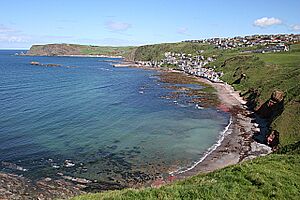Gamrie Bay facts for kids
Gamrie Bay is a lovely bay found in Aberdeenshire, a region in Scotland. It's a special place where the land meets the sea, offering stunning views and a peek into history. This bay is home to two charming villages and the remains of ancient buildings.
Contents
Gamrie Bay: A Scenic Scottish Spot
Gamrie Bay is a natural inlet of the sea, shaped by the powerful forces of nature over many years. It's a peaceful area, perfect for exploring the Scottish coastline. The bay's calm waters and surrounding cliffs make it a unique part of Aberdeenshire.
Where is Gamrie Bay Located?
This beautiful bay is situated along the coast of Aberdeenshire in northeastern Scotland. It lies between two prominent headlands: Crovie Head and More Head. These headlands act like natural guardians, protecting the bay from the open sea. Knowing its location helps us understand its coastal features.
Villages Nestled by the Bay
Within the sheltered curve of Gamrie Bay, you'll find two small, picturesque villages.
- Gardenstown: This village is known for its houses built right into the cliffs, looking out over the bay. It's a historic fishing village with a strong community feel.
- Crovie: Even smaller and more dramatic, Crovie is famous for its single row of cottages built right at the foot of the cliffs, with no road access in front of them. It's a truly unique place to visit.
These villages have a rich history tied to the sea and fishing.
Ancient Sites and Stories of Gamrie Bay
Gamrie Bay has a long and interesting past, with evidence of human activity stretching back centuries.
- Hill Fort and Castle of Findon: Near the entrance of Kirk Den, which leads into the bay, there once stood an ancient hill fort. Later, the Castle of Findon was built in the same area. These structures show that this location was important for defense and control in earlier times. They tell us about the people who lived here long ago.
- St John's Church: At the western end of the bay, you can find the ruins of St John's Church. This was once the main church for the local parish. Even though it's now in ruins, it stands as a reminder of the area's religious and community life from centuries past. It's a fascinating historical landmark.


